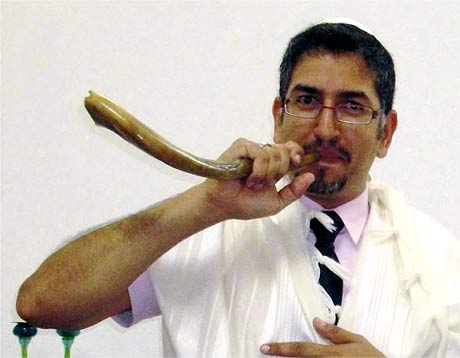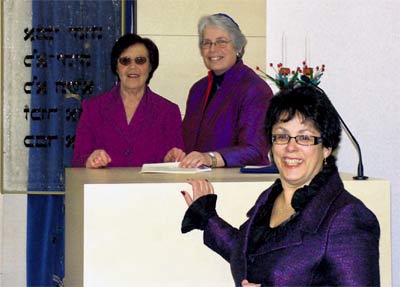Hamelin |
Return to News Archive September 15, 2012 |
No Fireworks on Rosh Hashanah

By Wolfhard Truchsess

| ||
Tomorrow, the Jewish New Year begins with the important Jewish holiday Rosh Hashanah. Ten days later, it is followed by the Day of Atonement, Yom Kippur. What do these important holidays mean to the Jewish community and how are they celebrated? And how does the Jewish year differ from the Gregorian calendar?
Tomorrow, Jews all over the world celebrate the holiday Rosh Hashanah, the beginning of a new year. According to the Jewish calendar, it’s the year 5773. Rosh Hashanah, and ten days later Yom Kippur, are the most important holidays, next to Shabbat in Judaism – regardless of whether a Jew is liberal, orthodox or orthodox. However, the celebration of the new year is not synonymous with New Year’s Eve. There are no fireworks and no parties on Rosh Hashanah because “Rosh Hashanah is a religious celebration of the new year rather than a secular celebration,” says Rachel Dohme, president of the liberal Jewish Congregation of Hamelin.
The Jewish year usually starts in September or October. The holiday will fall in September until 2020. The special design of the Jewish calendar is the reason why the Jewish year does not always start on the same day of the Gregorian calendar). “It’s a hybrid of the solar and the lunar calendar,” Rachel Dohme explains. “Unlike the Jewish calendar, the Gregorian calendar is a solar calendar only and the Muslim calendar a lunar calendar only.” That is why Ramadan, the Muslim fasting month, occurs at a different time each year. Also, the Jewish year with its 12 lunar months doesn’t have 365 but 353 to 355 days. In order to even out the gap between the Jewish and the Gregorian calendar, a 30-day intercalary month is added periodically before the Jewish month of Adar.
The actual celebration of Rosh Hashana starts with a special service and a festive meal or, Kiddush, on the evening before the first day of the Jewish month of Tischri, at sunset on 29th of the Jewish month of Elul . At Kiddush, apples and honey are served as a symbol of a “sweet life,” which one also wishes others by sending out New Year’s cards. One thing that must be done on this important holiday: Blowing the shofar, a ram’s horn. As Jonathan A. Romain and Walter Homolka write in their book “Progressive Judaism,” blowing the shofar is “a wakeup call to the conscience for a deeper feeling of the situation’s spiritual urgency.”
However, Rosh Hashanah is not just the religious beginning of a new year. “Mostly it’s a day of introspection, a day when either privately or at the synagogue with the congregation, inventory of the heart and soul is taken,” as Rachel Dohme puts it. In the following days up until Yom Kippur, which, this year, begins on the ninth day of the Jewish month of Tischri, or September 25th, Jews ask others for forgiveness and are forgiving toward them. In this context, Rachel Dohme emphasizes that the Christian term and concept of “sin” does not exist in Judaism. “We speak of error instead.” The president of the liberal Jewish congregation believes “that God wants us to work for peace and understanding. If we have done our best to get along with our fellow men, on Yom Kippur, we can feel worthy of asking God for forgiveness.”
Originally, Yom Kippur was a national day of penance for personal errors. On this day, every Jew should spend the day at the synagogue, consciously repenting his or her errors and ask for forgiveness and God’s mercy. “On this day, one feels that the soul can stand cleansed of errors before the Eternal,” as it says in the basic biblical text about Yom Kippur in Leviticus 16. However, there is no religious automatism for this purifying effect of the “Day of Atonement,” as Yom Kippur is best translated. Before that, you must first have followed the rabbi’s instruction of putting things in order with the person against whom you have wronged and forgive those who have wronged you. Otherwise, even the Day of Atonement will not bring atonement, as Romain and Homolka emphasize.
Unlike Rosh Hashanah, Yom Kippur does not start with a feast. Yom Kippur is a day of fasting, a day of complete abstinence: no food, no beverages, no physical pleasure, “because it is a day devoted solely to deep and concentrated prayer,” Rachel Dohme explains, “as this is our holiest day besides Shabbat. But for religious Jews,
|
|
Preparation for the High Holy Days is understandable to Christians when thought in terms of the Advent period. During the last month of the Jewish year, the month of Elul, there are special meditational prayers, with which the religious person can spiritually and mentally for the upcoming important holidays of Rosh Hashanah and Yom Kippur.
The name of this holiday has a historical connotation in the Middle East, namely the Yom Kippur War. On October 6, 1973, Egyptians and Syrians unexpectedly attacked Israel, presumably because they assumed Israeli soldiers to be praying in their synagogues. At first, they gained military advantages. The Jewish state, however, struck back and, led by then minister of defense Moshe Dayan, crossed the Suez Canal. Initially, the strategically important Golan Heights, which had been conquered during the Six-Day War in 1967, were hard-fought between Israeli and Syrian troops. Today, they remain one of the main issues between the two neighboring countries. Israel returned the Sinai Peninsula to Egypt in 1979 after negotiations and a peace treaty with President Sadat, who was later assassinated. In 1981, Israel regained the Golan Heights to permanently protect its northern border from rocket and artillery bombardment.

